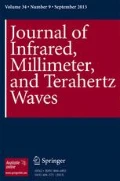Abstract
The rain attenuation was calculated by using the Marshall-Palmer, Best, Joss-Thomas-Waldvogel and Weibull distributions for raindrop-size. The results were compared with the recent measurements from 8 to 312.5 GHz at the rain rate R = 50mm/hr. Especially, the Weibull distribution has a good agreement with the measurements at 312.5 GHz (0.96 mm) in the submillimeter wavelength. Specific attenuation values from 1 to 1000 GHz were calculated for a rain temperature of −10°C, 0°C and 20°C by using the Weibull distribution.
Similar content being viewed by others
References
[1] Laws, J. O. and Parsons, D. A.: “The relation of raindrop-size to intensity”, Trans. Amer. Geophys. Union, 24, pp.452–460 (1943).
[2] Medhurst, R. G.: “Rainfall attenuation of centimeter waves: Comparison of theory and measurement”, Proc. of IEEE, AP-13, pp.550–564 (1965).
[3] Gunn, R. and Kinzer, G. D.: “The terminal velocity of fall for water droplets in stagnant air”, J. Meteor., 6, pp.243–248 (1949).
[4] Olsen, R. L., Rogers, D. V. and Hodge, D. B.: “The aRb relation in the calculation of rain attenuation”, Proc. IEEE, AP-26, pp.318–329 (1978).
[5] Sander, J.: “Rain attenuation of millimeter waves at λ=5.77, 3.3 and 2 mm”, IEEE Trans., AP-23, pp.213–220 (1975).
[6] Marshall, J. S. and Palmer, W. M.: “The distribution of raindrops with size”, J.Meteor., 5, pp.165–166 (1948).
[7] Best, A. C.: “The size distribution of raindrops”, Quart. J. Roy. Meteor. Soc., 76, pp.16–36 (1950).
[8] Joss, J., Thams, J. C. and Waldvogel, A.: “The variation of rain drop size distribution at Locarno”, Proc. Int. Conf. Cloud Phys., pp.369–373 (1967).
[9] Wickerts, S.: “Drop size distribution in rain”, FOA (National Defense Research Institute) Report, C20438-EI(E2), January (1982).
[10] Sekine, M. and Lind, G.: “Rain attenuation of centimeter, millimeter and sumillimeter radio waves”, Proceedings of the 12th European Microwave Conference, Helsinki, Finland, September, pp.584–589 (1982).
[11] Sekine, M. and Chen, C. D.: “Rain attenuation in terrestrial and satellite communications links”, Proceedings of the 15th European Microwave Conference, Paris, France, pp.985–990 (1985).
[12] Sekine, M.: “The relationship between radar reflectivity and rainfall rate”, Trans. IECE Japan (section E), 1986, E69, pp.581–582.
[13] Sekine, M.: “Rain attenuation from various raindrop-size distributions”, Trans. IECE Japan (section E), 1986, E69, pp.711–712.
[14] Sekine, M., Chen, C. D. and Musha, T.: “Rain attenuation from log-normal and Weibull rain-drop distributions”, IEEE Trans. Antennas Propagat., 1987, AP-35, pp. 358–359.
[15] Sekine, M., Musha, T. and Chen, C. D.: “Rain attenuation from Weibull raindrop-size distribution”, Proc. of the 18th European Microwave Conf., Stockholm, Sweden, 1988, pp. 423–428.
[16] Sekine, M. and Chen, C. D.: “Inversion problem in rain attenuation calculations”, Proc. of the 1989 URSI International Symposium on Electromagnetic Theory, Stockholm, Sweden, 1989, pp. 23–25.
[17] Jiang, H., Sano, M. and Sekine, M.: “Radar reflectivity and rainfall rate relation from Weibull raindrop-size distribution”, IEICE Trans. Commun., 1996, E79-B, pp.797–800.
[18] Jiang, H., Sano, M. and Sekine, M.: “Weibull raindrop-size distribution and its application to rain attenuation”, IEE Proc-Microw. Antennas Propag., 1997, 144, pp.197–200.
[19] Sayama, S. and Sekine, M.: “Influence of raindrop-size distribution on the differential reflectivity up to submillimeter wavelength of 0.96 mm”, International journal of Infrared and Millimeter Waves, 2002, 23, pp.775–784.
[20] Ishii, S.: “Rain attenuation at millimeter wavelength of 1.33 mm”, International journal of Infrared and Millimeter Waves, 2004, 25, pp.1495–1501.
[21] Sekine, M. and Lind, G.: “Raindrop shape limitations on clutter cancellation ratio using circular polarization”, IEEE Trans., AES-19, pp.631–633 (1983).
[22] Chen, C. D., Okamoto, Y. and Sekine, M.: “Cancellation of radar rain clutter using circular polarization”, Trans. of IECE of Japan, E68, 9, pp.620–624 (1985).
[23] Litvinov, I. V.: “On the distribution function of particle of rainfall”, Izvestia AN SSSR, Geophy. Ser. 6, pp.838–839 (1957).
[24] Fujiwara, M.: “Raindrop size distributions with rainfall types and weather conditions”, Res. Rep. 8, I11, State Water Survey (1961).
[25] Deirmendjian, D.: Electromagnetic Scattering on Spherical Polydispersions, New York, Elsevier, 1969.
[26] Sekhon, R. S. and Srivastava, R. C.: “Doppler radar observations of dropsize distributions in a thunderstorm”, J. Atmos. Sci., 28, pp.983–994 (1971).
[27] Fang, D. J. and Chem, C. H.: “Propagation of centimeter/millimeter waves along a slant path through precipitation”, Radio Science, 17, 5, pp.989–1005 (1982).
[28] Ajayi, G. O. and Olsen, R. L.: “Measurements and analysis of raindrop size distribution in south western Nigeria”, Proc. URSI Commission F 1983 Symposium, Louvain, Belgium, pp. 173–184 (1983).
[29] Ihara, T., Furuhama, Y. and Manabe, T.: “Inference of raindrop size distribution from rain attenuation statistics at 12, 35, and 82 GHz”, Trans. of IECE of Japan, E67, 4, pp.211–217 (1984).
[30] Rozenberg, V. I.: “Radar characteristics of rain in submillimeter range”, Radio Eng. And Elect. Phys., 15, pp.2175–2163 (1970).
[31] Ippolito, L. J.: “Radio propagation for space communications systems”, Proc. IEEE, 69, pp.697–727 (1981).
[32] Van De Hulst, H. C.: Light Scattering by Small Particles, New York, Wiley 1957.
[33] Deirmendjian, R., Clasen, R. and Viezee, W.: “Mie scattering with complex index of refraction”, J. Opt. Soc. Am., 51, pp.620–633 (1961).
[34] Ray, P. S.: “Broad complex refractive indices of ice and water”, App. Opt., 11, pp.1836–1844 (1972).
[35] De Bettencourt, J. T.: “Statistics of millimeter wave rainfall attenuation”, J. Rech. Atmos., 8, pp.98–112 (1974).
[36] Babkin, Y. S., Zimin, N. N., Izyumov, A. O., Iskhakov, I. A., Sokolov, A. V., Stroganov, L. I., Stroganov, Y. V., Sukhonin, Y. V. and Shabalin, G. Y.: “Measurement of attenuation in rain over 1 km path at a wavelength of 0.96 mm”, Rad. Eng. Elec. Phys.,15, pp.2164–2166 (1970).
Author information
Authors and Affiliations
Rights and permissions
About this article
Cite this article
Utsunomiya, T., Sekine, M. Rain Attenuation at Millimeter and Submillimeter Wavelengths. Int J Infrared Milli Waves 26, 905–920 (2005). https://doi.org/10.1007/s10762-005-5662-5
Received:
Published:
Issue Date:
DOI: https://doi.org/10.1007/s10762-005-5662-5




